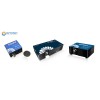Your shopping cart is empty!
VIS-NIR Spectrometer in Transmittance Applications
This article introduces the applications, principles, and conclusion analysis of Optosky's VIS-NIR spectrometer in transmittance measurements.
1.VIS-NIR Spectrometer
Optosky spectrometers are an essential part of optical instruments. They utilize optical principles to measure, analyze, and process the structure and composition of substances. These spectrometers offer high analytical precision, a wide measurement range, and fast speed.Currently, most visible near-infrared spectrometers on the market use back-thinned or coated CCDs as photosensitive elements, which are relatively expensive. Therefore, this paper proposes a design solution that applies cost-effective CMOS sensor chips in visible near-infrared spectrometers. The system uses optical fibers as light guide elements and a grating for light splitting. The processed light beam is parallelly projected onto the sensor surface, converted into electrical signals, and then uploaded to the host computer through A/D conversion, signal storage, and transmission in the circuit section. This enables spectral image display and analysis.In the design, to ensure that the sensor's photosensitive elements receive uniform, monochromatic, and high-resolution parallel light beams, a reasonably sized optical system must be constructed. The paper concludes with experimental comparisons, verifying that the visible near-infrared fiber optic spectrometer designed with this solution exhibits good sensitivity in the visible wavelength range, with a spectral range of 200 nm to 1100 nm and a resolution of up to 2.0 nm.
2.Application Principle
First, light emitted from the light source is transmitted to the spectrometer through optical fibers. The introduction of optical fibers makes sampling more flexible, adapting to the complex shapes and positions of the samples being measured. When light interacts with transparent materials like glass, it exhibits reflection, absorption, and transmission properties. Transmitted light refers to the portion of light energy that passes through the material after reflection and absorption losses. The variation in light energy before and after passing through the material represents the material's transmission properties, expressed as transmittance.Inside the spectrometer, the light signal first passes through an entrance slit and is projected onto a collimating lens. The slit restricts the range of incoming light, while the collimating lens converts the divergent light into a nearly parallel beam. The nearly parallel light is then projected onto a dispersion element, typically a diffraction grating. The grating disperses the light into its component wavelengths, creating a spectrum. This dispersion process relies on the wave nature and interference effects of light, with different wavelengths diffracting at different angles, thereby separating the spectrum.The dispersed light is then reflected by an imaging mirror and projected onto the surface of an array detector. Each pixel of the detector corresponds to a small spectral band within the spectrum, enabling the measurement of the entire spectrum. The detector analyzes and processes the light signals to obtain spectral information. By analyzing and processing this spectral information, the transmission characteristics and related parameters of the measured substance, including transmittance, can be determined.Overall, the application principle of visible fiber optic spectrometers for transmittance involves utilizing optical interference, dispersion, and transmission properties of light. Optical fibers guide the light signals into the spectrometer, where dispersion through the grating and detection by the detector allow for the acquisition of spectral information such as transmittance. This method has extensive applications in material science, optical research, and other fields. The spectrometer used has a wavelength range of 200-1110 nm, wavelength accuracy of ±0.5 nm, and wavelength repeatability of ±0.1 nm (with a wavelength temperature drift of 0.4 nm/10°C).
3.Samples And Test Methods
There are five types of test samples in this test:
5 filters with different transmission positions
The visible and near-infrared micro-fiber spectrometer ATP2400 produced by Optosky was used.
Test conditions: integration time 80 us, average times 5 times, scanning range 200-1110nm, room temperature.
4.Test Results And Analysis
4.1 Sample Relative Intensity Comparison
Figure 1: Sample Relative Intensity Comparison
4.2 Sample Transmittance Comparison
Figure 2:Sample Transmittance Comparison
5.Conclusion
The conclusions of transmittance testing mainly depend on specific test conditions, test samples, and the performance of the spectrometer used. We can observe that the Optosky ATP2400 fiber optic spectrometer was used to test the transmittance of five glass samples.In the 500-700nm wavelength range, the transmittance of these four glass samples is generally high, but the differences between them are minimal. Among them, the transmittance positions of samples 2 and 3 do not differ much, with a transmittance difference of about 4%, while samples 4 and 5 also have similar transmittance positions, with a difference of about 2%. Sample 1 has a significantly different transmittance position and transmittance compared to the other samples. However, this does not necessarily mean that the performance differences of these samples in this wavelength range are not significant; specific judgments need to be made based on the application scenarios and requirements.Moreover, the conclusions of the transmittance tests are also influenced by the performance of the spectrometer. The Optosky ATP2400 fiber optic spectrometer features a compact structural design, configurable spectral range, high resolution, and low stray light, which help obtain more accurate and reliable transmittance test results.In summary, the conclusions of transmittance testing need to be comprehensively judged based on specific test conditions, samples, and spectrometer performance. In practical applications, other factors such as sample thickness, surface condition, and light source stability also need to be considered to obtain more comprehensive and accurate transmittance test results.
Search
Categories
Popular Posts
Latest Posts

-1000x400.png)
.png)
.png)
.png)




-100x100.png)
















Comments: 0
No comments